How to Microwave Butternut Squash or Cook it in the Oven

Cooking butternut squash is simple—roasted, baked, or microwaved, butternut squash is your best bet to add flavor to your recipes or as a side dish.
It's not officially fall until you add a few fresh butternut squash recipes to the menu. You can cube and roast it for an easy side dish, microwave butternut squash and mash it for an autumn-themed riff on mashed potatoes, and even puree it to make soup. No matter how you decide to use it, follow our step-by-step instructions for how to cook butternut squash (as well as how to peel, chop, and store it), and you'll be adding it to your menu week after week.
Related: Butternut Squash Gnocchi with Herbed Brown Butter
How to Prepare Butternut Squash
Before you start cooking, you've got to prep your squash. Follow these tips to get butternut squash ready for the oven or microwave.
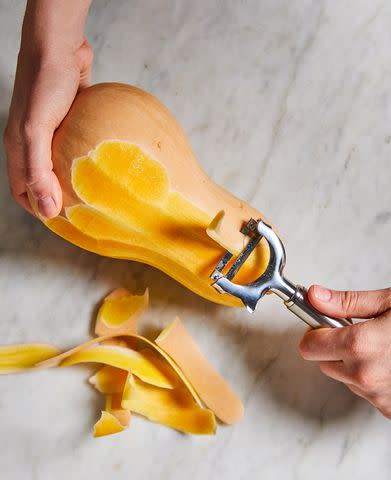
How to Peel Butternut Squash
Start by thoroughly rinsing the squash under cool tap water and scrubbing with a clean produce brush. Pat dry with a paper towel like these reusable paper towels ($10, Amazon). Then, with the top of the squash (the neck) pointed toward you, start in the middle and use a Y-peeler ($13, Amazon) to peel in firm strokes to the stem. Rotate the squash and repeat with the bottom half (the body).
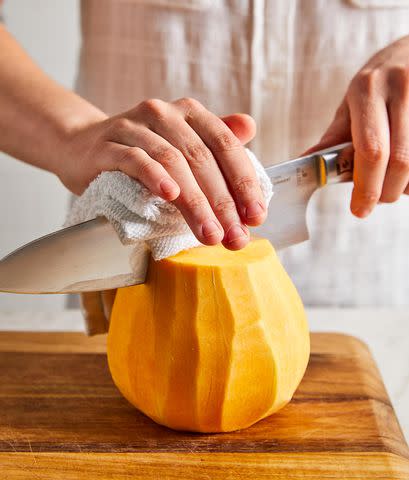
How to Cut Butternut Squash
If you're serving cubed or sliced squash, cutting it up first will make it much easier to work with. To begin cutting your squash, lay it on its side. Trim the top and bottom to remove the stem using a large, sharp chef's knife ($100, Crate & Barrel). Stand the squash upright, then cut straight down lengthwise through the middle if you want to maintain the shape of the squash and work with two halves. For easier handling, trim the top and bottom, cut in half crosswise, then each section of squash in half lengthwise (as pictured above). You'll end up working with four smaller pieces instead of two.
Test Kitchen Tip
To prevent the squash from slipping, use your non-dominant hand to stabilize the squash, and make an initial cut by using light pressure to penetrate the squash's flesh. That first cut will make slicing through the squash easier and safer.
Related: The 11 Best Chef’s Knives of 2023

How to Remove Seeds from Butternut Squash
Scrape the seeds and any pulp or stringy pieces using a large spoon. That's it. Your butternut squash is ready to place cut-side down to roast, slice or chop as needed for your recipe.
Test Kitchen Tip
Don't toss those squash seeds! Instead, turn them into an afternoon snack by roasting them. Rinse, drain, and dry the seeds with a paper towel. Toss with salt and olive oil. Roast on a baking sheet at 300°F for 50 to 60 minutes or until crisp, stirring every 15 minutes.
Related: Savory Butternut Squash Dressing
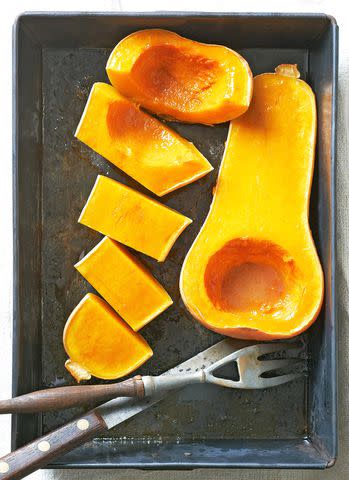
How to Cook Butternut Squash in the Oven
Bake butternut squash in the oven when you want to serve it mashed, or enjoy each piece as a single serving and eat it with a spoon.
Clean squash, cut in half (or quarters), and remove seeds as directed above.
Place squash pieces, cut sides down, in a baking dish or foil-lined pan. Bake in a 350°F oven 45 to 50 minutes or until tender. To check doneness, pierce the squash with the tip of a sharp knife. It should slide in easily.
Carefully turn squash pieces over (a set of large tongs works well). Scoop out flesh into a bowl. Add seasonings as desired and mash to add to baked butternut squash recipes, or enjoy as is.
Related: Butternut Squash with Maple and Bourbon
How to Microwave Butternut Squash
Microwave butternut squash and save over half an hour of cooking time.
Clean squash, cut in half (or quarters), and remove seeds as directed above.
Place squash pieces, cut sides down, in a baking dish with 2 tablespoons water. Cover with plastic wrap, and make a few slits in the wrap to allow steam to escape. Microwave on 100% power (high) for 9 to 12 minutes or until tender, rearranging once. To check doneness, pierce the squash with the tip of a sharp knife. It should slide in easily. (You can test it through the plastic wrap.)
Carefully turn squash pieces over. Scoop out flesh into a bowl. Season as desired and mash, or add to a recipe.
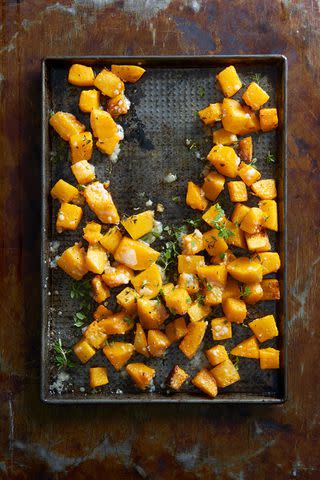
Roasting Butternut Squash
Roasting butternut squash pieces caramelizes their exterior while keeping them moist and tender inside. Toss roasted squash into soups or salads, throw them on a pizza, or use them to fill omelets, quesadillas, or sandwiches. They're also perfect as a simple side dish. Follow these simple steps to learn how to roast butternut squash.
Clean squash, peel, cut, and remove seeds as directed above. Cut squash into 1-inch cubes or ½-inch-thick slices.
Toss squash with olive oil to coat and prevent drying out while roasting. Spread in an even layer in a foil-lined baking pan ($26, Amazon).
Roast in a 450°F oven, uncovered, 30 to 35 minutes or until tender and brown on the edges, stirring once.
Related: Crispy Parmesan-Roasted Butternut Squash
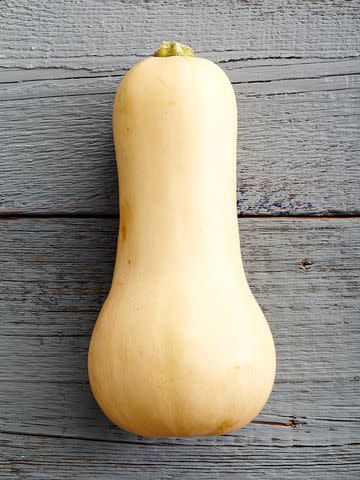
How to Select and Store Butternut Squash
Butternut squash, a common winter squash, starts appearing in markets in the fall. This bowling pin-shaped squash has a firm, dense flesh that doesn't get stringy after cooking, giving it a creamy texture that's great for mashing. The deep orange flesh of this squash is high in beta-carotene, fiber, vitamins C and B6, and potassium.
Selecting: Choose butternut squash that feels dense and heavy with no blemishes or soft spots. The skin should appear uniform and flat, not glossy. Look for squash with no cracks and the stem still attached, which helps prevent the flesh from drying out. When planning for recipes, note that one 2-pound squash will yield about 5 cups cubed or 6 cups spiralized.
Storing: Butternut squash will last several months stored in a cool, dry place between 50°F and 60°F. Don't store near apples, pears, onions, or potatoes; these foods produce ethylene gas, which can spoil squash. Once cut, wrap in plastic wrap (or DIY beeswax food wraps!) and refrigerate for several days.
Don't stop at butternut squash! Fall and winter are seasons for plenty of other squash varieties, like acorn squash, spaghetti squash, and even pumpkins. Learn how to cook them all, and you can take full advantage of squash hitting grocery stores and markets this season.
For more Better Homes & Gardens news, make sure to sign up for our newsletter!
Read the original article on Better Homes & Gardens.

